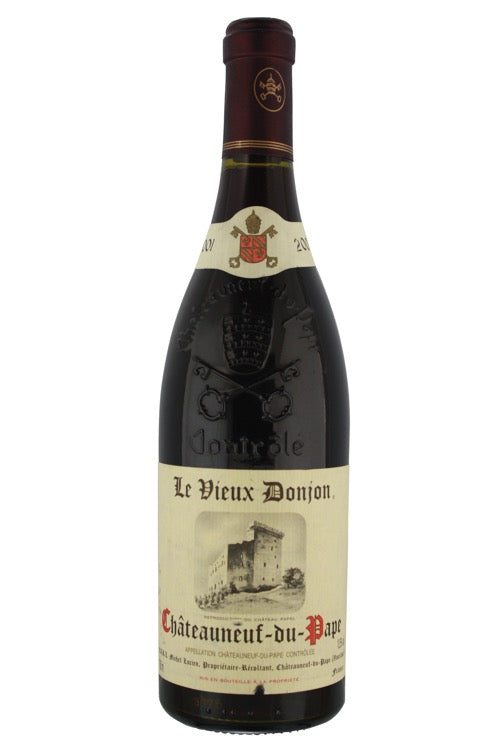1
/
of
1
Le Vieux Donjon Chateauneuf-du-Pape - 2001 (750ml)
Le Vieux Donjon Chateauneuf-du-Pape - 2001 (750ml)
Regular price
$199.99
Sale price
$199.99
Regular price
$199.99
Unit price
/
per
The 2001 Chateauneuf du Pape is a beauty! Classic and textbook in style, with ample cured meats, earth, herbs and mature currant and blackberry fruit, it flows onto the palate with full-bodied richness, a gorgeous texture and serious length. It’s drinking beautifully now, but will continue to shine through 2021.
Another bastillion of traditional Chateauneuf du Pape, Vieux Donjon is owned by Lucien and Marie Jose Michel, with the winemaking now firmly in the hands of their talented daughter, Claire Michel. They produce a single red and white Chateauneuf du Pape, with the red always a rough blend of 75% Grenache, 10% Syrah, 10% Mourvedre and the balance a mix of other permitted varieties. They started partial destemming in 1993, pulling out the green stems and keeping the more lignified stems. Aging occurs all in concrete tanks and older foudre. This was a fabulous tasting with both Claire and her brother Francois, and as I hope the notes show, the wines have classic Chateauneuf du Pape character and broad drink windows.
Wine Advocate - 95 points
Wine Advocate - 95 points
Availability:
1 In Stock
$25 Shipping on Orders +$299
Couldn't load pickup availability
Share :

- varietal
- Region
- Sub - Region
- Type
- Reviews
Product Review
The 2001 Chateauneuf du Pape is a beauty! Classic and textbook in style, with ample cured meats, earth, herbs and mature currant and blackberry fruit, it flows onto the palate with full-bodied richness, a gorgeous texture and serious length. It’s drinking beautifully now, but will continue to shine through 2021.
Another bastillion of traditional Chateauneuf du Pape, Vieux Donjon is owned by Lucien and Marie Jose Michel, with the winemaking now firmly in the hands of their talented daughter, Claire Michel. They produce a single red and white Chateauneuf du Pape, with the red always a rough blend of 75% Grenache, 10% Syrah, 10% Mourvedre and the balance a mix of other permitted varieties. They started partial destemming in 1993, pulling out the green stems and keeping the more lignified stems. Aging occurs all in concrete tanks and older foudre. This was a fabulous tasting with both Claire and her brother Francois, and as I hope the notes show, the wines have classic Chateauneuf du Pape character and broad
Product Score
95
Includes red wines where there is either no predominant variety or the blend is proprietary.
The Rhone is one of France’s most important wine regions. Divided into two separate zones, the north is probably the most prestigious. It is home to the appellations of Condrieu, Côte Rôtie, St. Joseph, Hermitage, and Crozes-Hermitage. Syrah is king with the exception of the Condrieu (100% Viognier) and Hermitage, which also makes big whites from Marsanne and Roussanne. The South is a much larger region where most Cotes du Rhone and Cotes du Rhone Village come from. In the villages of Châteauneuf-du-Pape, Gigondas, Vacqueyras, and Rasteau, Syrah is blended in varying proportions with Grenache, Mourvedre, Cinsaut, and a host of obscure varieties such as Muscardin, Vaccarese, Terret and Counoise, to produce full-bodied reds brimming with energy.
Châteauneuf-du-Pape is the most famous village in the southern Rhone. It is here that Grenache, the primary varietal, is arguably at its very best. Syrah, Mourvedre, and Cinsaut are also normally included however the proportions can vary significantly from producer to producer. In some cases (Château Beaucastel), all thirteen permitted varieties are included. They are often very age-worthy wines with incredible depth and concentration, and which develop complex secondary aromas including dried fruit, spice and earth.
Red wine is wine made from dark-coloured grape varieties. The color of red differs based on the grapes variety or varieties used.Interestingly, black grapes yield a juice that is greenish-white. The actual red color comes from anthocyan pigments (also called anthocyanins) from the skin of the grape (exceptions are the relatively uncommon teinturier varieties, which produce a red colored juice). Most of the production centers around the extraction of color and flavor from the grape skin.


